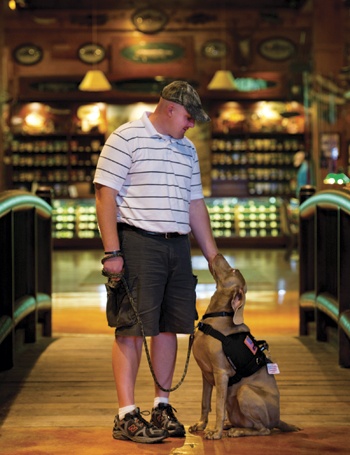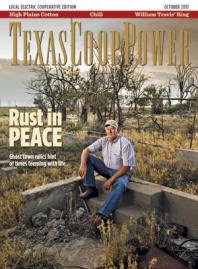Luis* is a former Marine who served in Vietnam in 1967. Like many veterans, he had terrible nightmares, which left him exhausted and sleepless. Since March, Luis has slept better than he has in years thanks to his dog, Blue, a blue heeler (also called an Australian cattle dog) he received from the Train A Dog-Save A Warrior program.
Blue sleeps next to his bed. “If I have a nightmare, Blue jumps up on the bed and snaps me out of it, and I can go right back to sleep,” says Luis, a member of Guadalupe Valley Electric Cooperative. “I can’t do without her now.”
Train A Dog-Save A Warrior, or TADSAW, a nonprofit organization based in San Antonio, was founded by pharmacist Bart Sherwood. Active-duty and retired members of any branch of the military can qualify for a therapy dog by being diagnosed with post-traumatic stress disorder, military sexual trauma, traumatic brain injury or by having symptoms of these disorders, says Sherwood.
Dogs have been helping humans with disabilities for thousands of years. In the ruins of the Roman city Herculaneum, dating to the first century, archeologists found a fresco in which a dog is leading a blind man. The modern guide dog movement began in Germany after World War I, according to the International Guide Dog Federation, when thousands of soldiers blinded by mustard gas needed assistance.
By 1975, organizations were training dogs to help people with muscular dystrophy or cerebral palsy. Today, many medical studies have shown that holding and petting a dog can lower blood pressure, decrease production of the stress hormone cortisol and increase production of oxytocin, which can increase feelings of well-being.
Dogs can sense when someone is suffering, Sherwood says. He describes the experience of veterans who experience anxiety attacks. The dog comes into contact with the veteran, as if to say, “Focus on me, and we can make it through,” he says.
TADSAW has established training groups near many military bases, including Fort Hood in Killeen, Fort Bliss in El Paso, Camp Lejeune and Fort Bragg in North Carolina, and Fort Sill in Oklahoma.
In San Antonio, veterans and dogs go through training together every Tuesday and Friday afternoon at a park near Randolph Air Force Base. Sometimes the dog is the soldier’s personal pet that TADSAW trainers have deemed fit to become a therapy dog. Other times, the dog is provided by TADSAW—many come from shelters. They can be any breed.
“We select based on temperament and size,” Sherwood says. “We look for a kind eye—how they respond to doing a task. We look for dogs that are not aggressive or aggressively friendly.”
On a sunny day in May, more than a dozen service members went to the Bass Pro Shops in San Antonio so their dogs could be given TADSAW Public Access Temperament Test and AKC Canine Good Citizen tests. There’s a Chihuahua in the group, a golden retriever, a German shepherd, some Labradors, a Weimaraner and several mixed-breed dogs.
Gathered in the lobby, all dogs sit calmly on the floor, each one seated next to his or her owner. None of the dogs are pulling, growling, nudging or sniffing each other, the way an ordinary group of dogs might. Instead, they watch carefully, frequently looking at their owners for cues and not getting distracted when a small child carrying food runs past. The dogs are peaceful, their expressions serene.
Carolyn Keiser, the owner of K-9 Behavior in La Vernia and a member of GVEC, is the trainer who has been working with this group at Randolph. Keiser has more than 30 years of dog-training experience.
“The best part is seeing these veterans’ lives change,” Keiser says. “I learn a lot about them. When they first come to the training group, a lot of them don’t socialize, go to restaurants or to their children’s plays. Once they have a service dog, they can go out and live a regular life again. It’s wonderful to watch the bond develop between the dog and the person. It’s an amazing thing to watch the change in the people.”
Jason has been in the Army since 2003. He went to Iraq in 2004, serving a 13-month tour of duty. Jason, a member of GVEC, heard about TADSAW through the Wounded Warrior Project, an organization that helps wounded service members. His service dog is Reeva, a Weimaraner with compassionate golden eyes who was rescued from a shelter.
Before Reeva joined his family, Jason mostly stayed home. With her, he goes grocery shopping and to his children’s school and even took a trip to Georgia, something that would have been unimaginable before having a therapy dog. “I keep my mind on her instead of on what I’m feeling,” Jason says. “She’s definitely been helpful with depression. Reeva makes me get up and get out of the house.”
Nickol was in the Army from 2008 to 2012. Her service dog is Ava, a German shepherd also rescued from a shelter. Nickol, a single mother of a 3-year-old son, is pursuing a degree in multidisciplinary science at University of Texas at San Antonio. Looking at the other service members and their dogs, Nickol says, “Every single one of us has different needs and a different lifestyle. Each dog is paired up with a veteran to ensure the dog meets the needs of the warrior. We all suffer from different forms of anxiety.”
For her, having Ava has made the world a more inviting place. She and a friend from TADSAW took their service dogs to the Poteet Strawberry Festival in April. “Last year I wouldn’t have gone,” she says. “Now I can go because of my dog.”
——————–
Michele Chan Santos is an Austin writer.
*Editor’s note: Only the first names of service members have been used at the request of the Train A Dog-Save A Warrior program.


